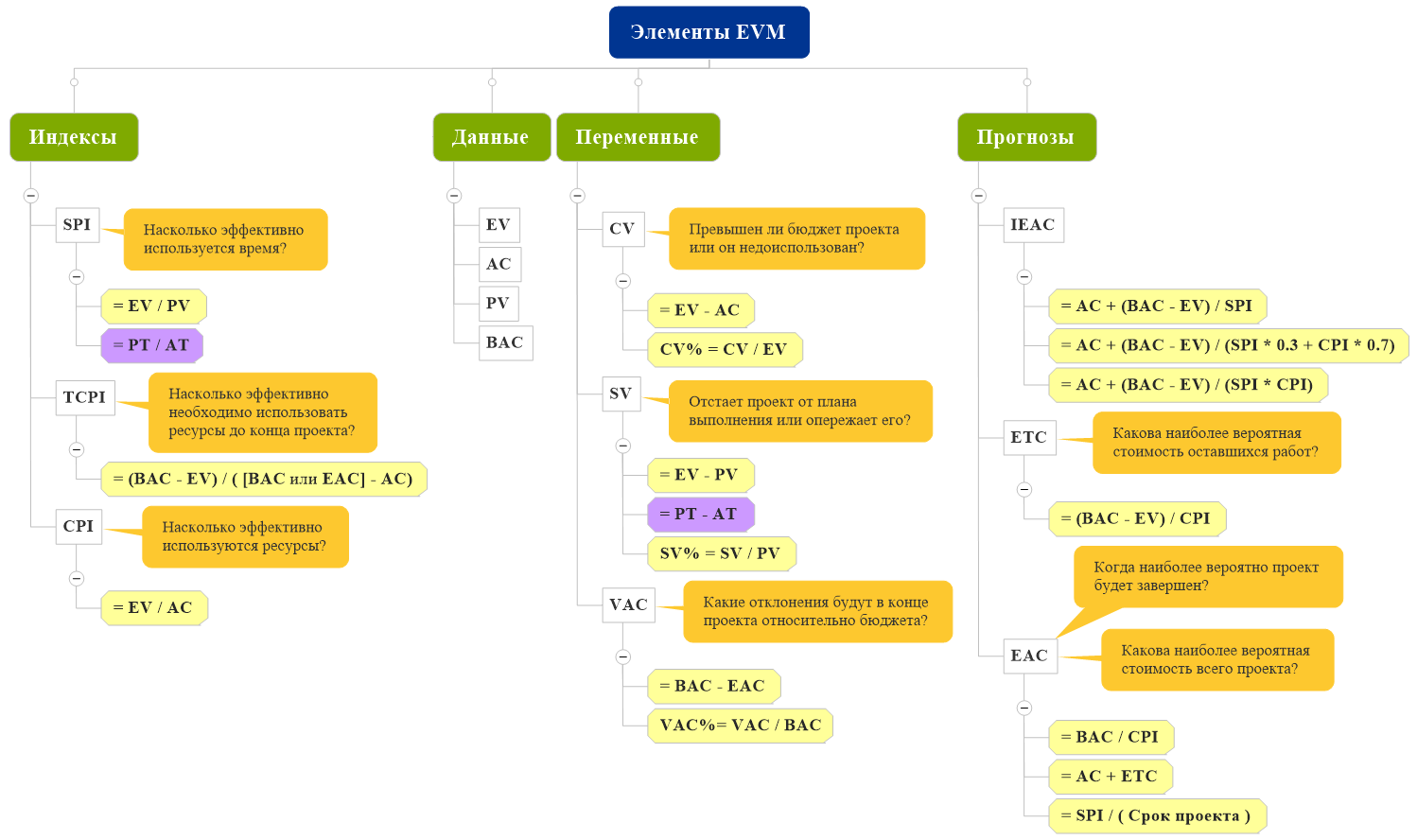Manage project cost with Earned Value Management
How to measure and monitor the effectiveness of the execution of project plans - such questions are a constant headache for their managers. There are many approaches to solving these problems. In this article, we will look at the main elements of the technology for managing the mastered volume (Earned Value Management, EVM), which is used throughout the US projects, and we are only gaining popularity in project management, taking into account the update Standard Practice for Earned Value Management, PMI. (In 2012, I already wrote in one well-known journal about it in narrow circles.) You can learn how to use EVM, and in the comments let's discuss who and how it worked out from experience. In LANIT, we use the approaches of Earned Value Management not everywhere, but we try to use the best techniques. Also willing to share your best practices with you.
 A source
A source
Each manager wants a clear understanding of the state of his project and an answer to the questions: does the project lag behind or is ahead of the implementation plan, how efficiently are resources used, is the budget exceeded or is there savings, what is the cost of the remaining work? For a project to be successful, you need to carefully manage each of its components and processes. The project manager needs constant feedback in order to see possible problems in time and solve them in order to do everything on time and meet the budget.
Earned Value Management helps you manage these tasks. It integrates in itself the analysis of the entire scope of work on the project with the work execution plan and the cost of its implementation. Thanks to her, one can observe the main metrics of the state of the project and assess the real state of affairs, making the necessary managerial adjustments.
')
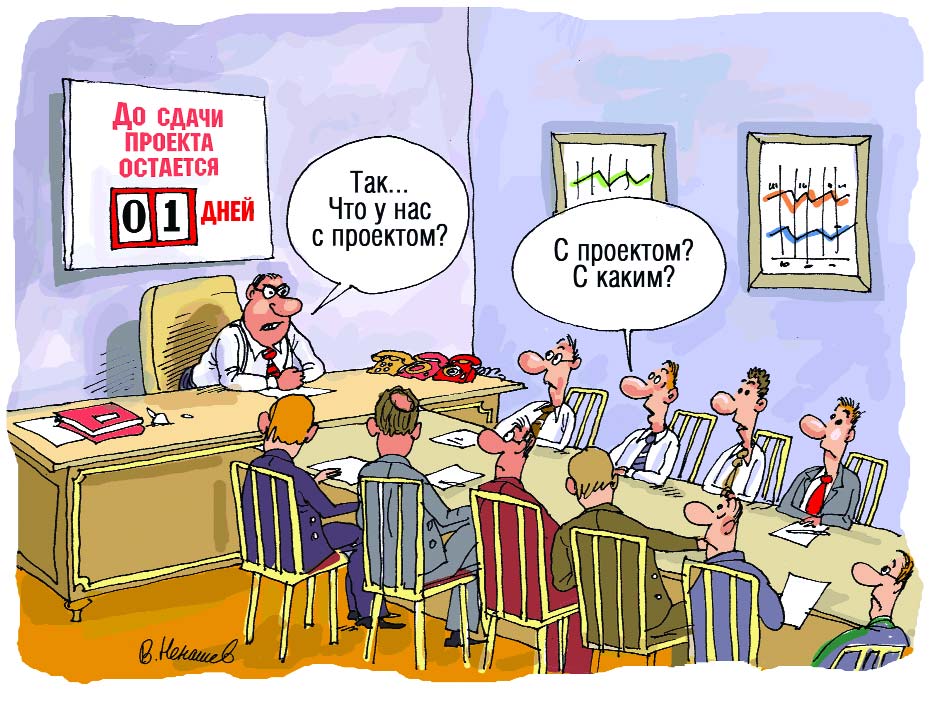 A source
A source
You are the manager and decide that you will use Earned Value Management. Talk about the practical steps you need to take. First, project planning, then measuring and analyzing the timing of the work and their cost as the project objectives are accomplished.
We determine the full scope of work: what should be developed and delivered to the customer. The volume is indicated in the content of work (Statement of work, SOW), we have this term has the usual names - technical assignment, technical / functional requirements. Based on this, a project execution plan is drawn up and the cost is calculated. The beginning is simple, just like in the classics.
 A source
A source
Each work is divided into component tasks, which allows you to better control the execution of the plan - work decomposition is performed. After all, it is not for nothing that “an elephant is eaten piecemeal.”
The hierarchical structure of work (WBS, Work breakdown structure, WBS) allows you to specify the project to manageable parts - elements that cover the entire scope of work. To the leaves of the WBS tree, the works are increasingly detailed.
 The hierarchical structure of the work of creating a software product
The hierarchical structure of the work of creating a software product
Now we define the contractors and their areas of responsibility - we are preparing the organizational structure of the project team (OS, Organizational breakdown structure, OBS).
 Organizational structure of the project team
Organizational structure of the project team
After that we strengthen control over the project, designating control points. For them, we determine the amount of work required to perform, the budget and the plan of the work itself. In the future, when carrying out monitoring activities, we will first look at these points for analyzing the amount we have acquired and the actual costs incurred.
Responsibility for these points, the roles of the participants are specified in the Responsibility assignment matrix (RAM) - we carry out the intersection of the WBS (a workload, responding to the question “What should be done?”) And OBS (project participants, responding to the question “Who is responsible for completing the task? ”), thereby determining those responsible for the control points. One person in charge may be responsible for several control points, but a control point cannot be controlled by several persons responsible.
In this figure, control points are highlighted in yellow.
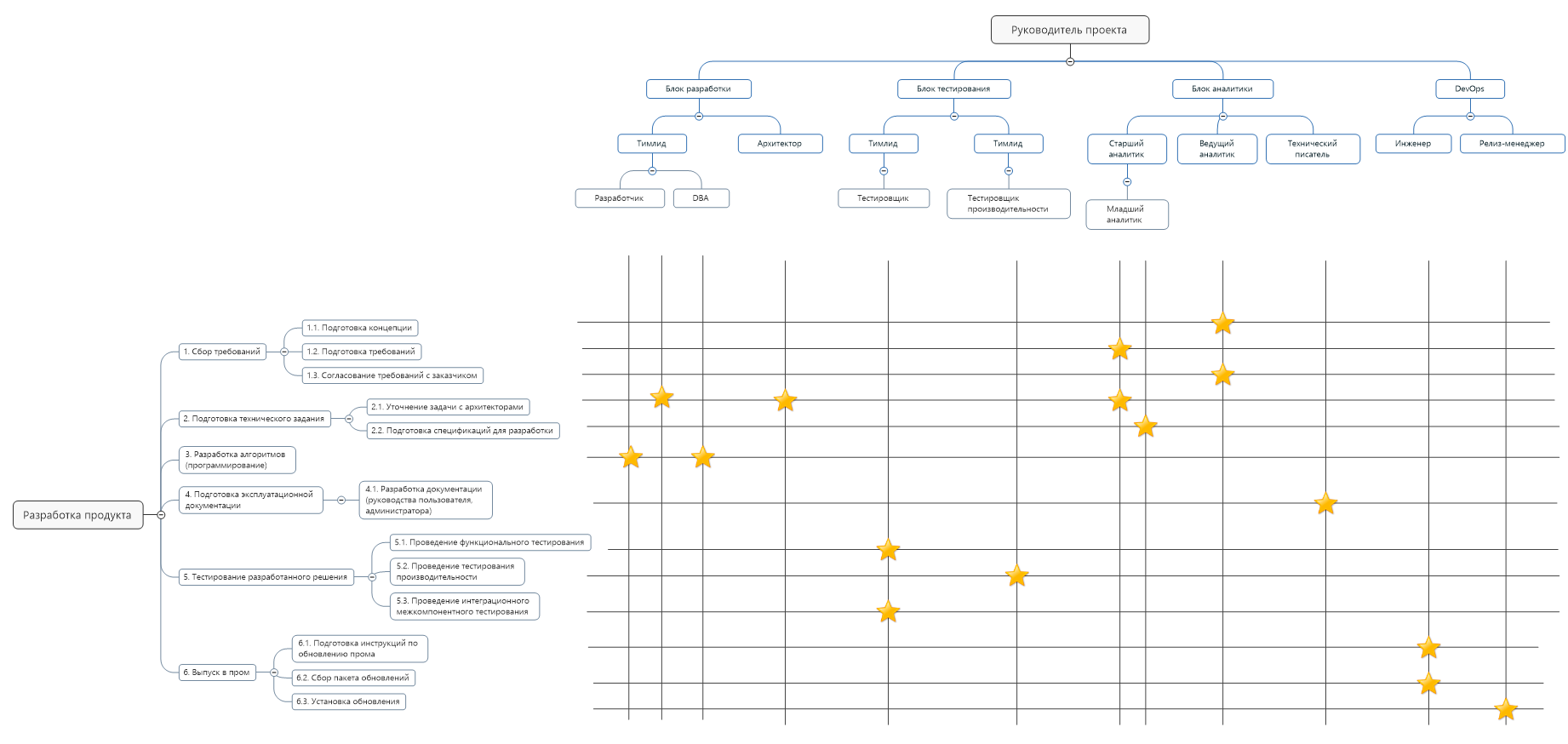 Determination of control points
Determination of control points
We make the main project execution plan (integrated master schedule, IMS). In terms of all the tasks are divided into stages of the execution of tasks (up to the lowest level of the WBS), indicating their duration and logical connections. Then we mark the budget for each task.
 Main project implementation plan
Main project implementation plan
To use Earned Value Management, the work plan must be integrated with the planned project costs. At the very end of the IMS planning (I highly recommend it then) it is necessary to develop a budget. The budget must be clearly tied to the time intervals of the tasks in order to understand when and how much budget funds will be spent.
 A source
A source
The project budget is one of the main elements of Earned Value Management. It is taken into account:
 Option development project. Display example EV, PV and AC
Option development project. Display example EV, PV and AC
From the example I mentioned above, the situation on the project is visible - the analytical block of work was carried out ahead of time, but from the moment the requirements were agreed upon, a deviation from the plan began, including in the development ...
The sum of all budgets of control points and the unallocated budget is the basic level of performance measurement (Performance measurement baseline, PMB). It is useful to us to compare the cost during the implementation of the work plan.
You can measure the resources used in any convenient units of measurement (for example, in working hours, in monetary terms of the resources used, which make up the budget, etc.).
Consider the basic tenets of EVM technology:
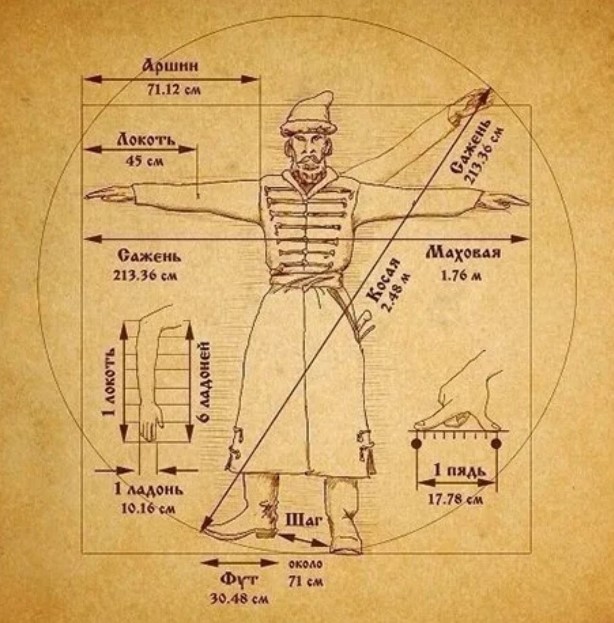 A source
A source
There are several basic approaches to determining the progress of a task.
Fixed formula
Convenient for small tasks. An example of such an approach is the 50/50 method, when 50% of the completion of tasks are indicated at the start of their execution, and the remaining 50% - at the end. Alternative formulas 25/75 and 0/100 may be used. My favorite ratio is 10/70/20 (start of work, significant execution of the task, and completion of its execution) - allows you to go through a three-stage assessment process 0% → 10% → 80% → 100%.
Weighted check points and
Effective for long-term tasks when there are intermediate results. The task is divided into parts. The end of each part is the control point. After each checkpoint is reached, the task is assigned the appropriate percentage of its completion.
Execution percentage
This is a simple but subjective approach, in which the person in charge of the task himself assesses the percentage of completion of the planned work for the period. Such an assessment is not always effective and believable, but such an approach also takes place.
If there are any quantitative indicators, the percentage can be calculated on their basis. For example, 65,356 out of 110,320 migrated, i.e. 59%.
Distributed work
If the task is associated with another task that has its own EV, the value for the dependent task can be determined based on the main task. These may be synchronous tasks.
Level of load (LOE)
If the result of the task is intangible and the other listed approaches cannot be applied, then use this approach. For example, for such tasks as project management or technical support for users, those responsible for the tasks are occupied for a fixed% of the time. Thus, it is sufficient to simply calculate how much progress there will be if the responsible persons are engaged in these tasks.

Earned Value Management allows you to identify possible deviations from the plans by analyzing your main elements - the amount mastered, the work plan and actual expenses. Based on them, you can determine:
How to calculate them? The calculation formulas are simple. Here they are:
; ; ;
If the first two indicators are negative, pay special attention to this, you have a deviation on the project not for the better.
In case the last two indices are greater than or equal to 1, the project is in excellent shape. Conversely, if less than 1, this means that there is a problem in the timing or cost of the project.
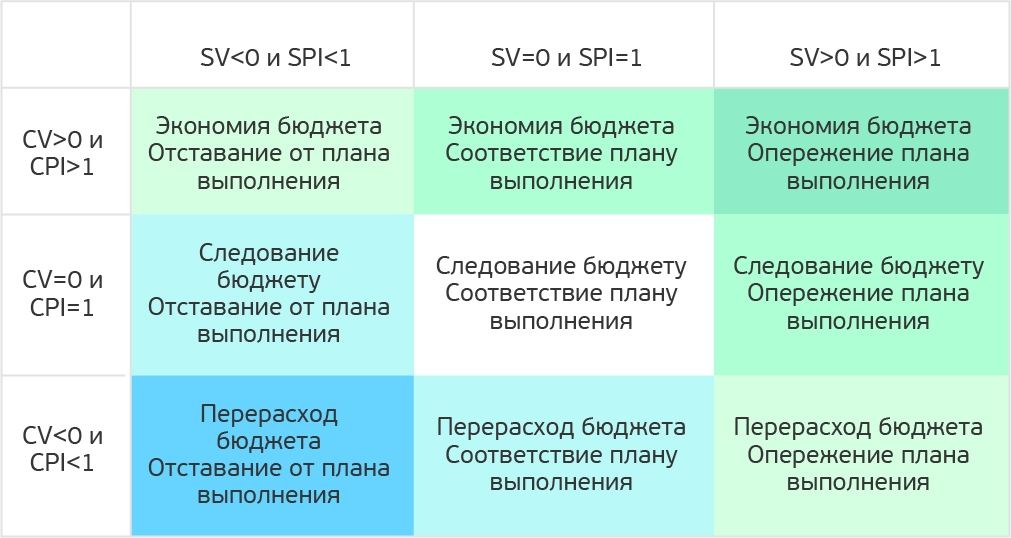 Project status depending on indicators
Project status depending on indicators
There are other useful elements in EVM for analyzing a project that allow you to answer questions about how much work is left to be done, how much money is left to spend, whether the forecasts are consistent with the current progress of the work. I will give these elements below.
Project completion forecast (Estimate at completion, EAC)
It allows you to determine when the project will end and how much money will be spent on it, taking into account the current trend.
Deviations on completion (Variance at completion, VAC)
Informs about savings or cost overruns at the end of the project in absolute or relative terms for the period.
Performance Index to completion (To complete performance index, TCPI)
Shows the required efficiency of the team using the remaining resources so that at the end the cost corresponds to the BAC values (or EAC, if it was calculated by an expert method). After determining the index, you need to determine what action to take to change the CPI in the direction of the new value equal to TCPI.
Forecast to completion (Estimate to complete, ETC)
Shows the estimated costs of the remaining project work. It can be calculated and expert way, and with the help of mathematical calculations based on the efficiency of the work, determined by the CPI.
Following the results of the forecasting of the project plan execution, I recommend that you record the results of the forecasting and measurement procedures in the charts / pivot tables, this will help to see the trends and the life of the project, its history. We do not forget to take corrective management actions to preserve the successful implementation of the project, because it is not without reason that change management is one of the core competencies of a project manager in the IT world.
To understand how the elements of EVM are related to each other, below I will draw a graph of the dependence of elements.
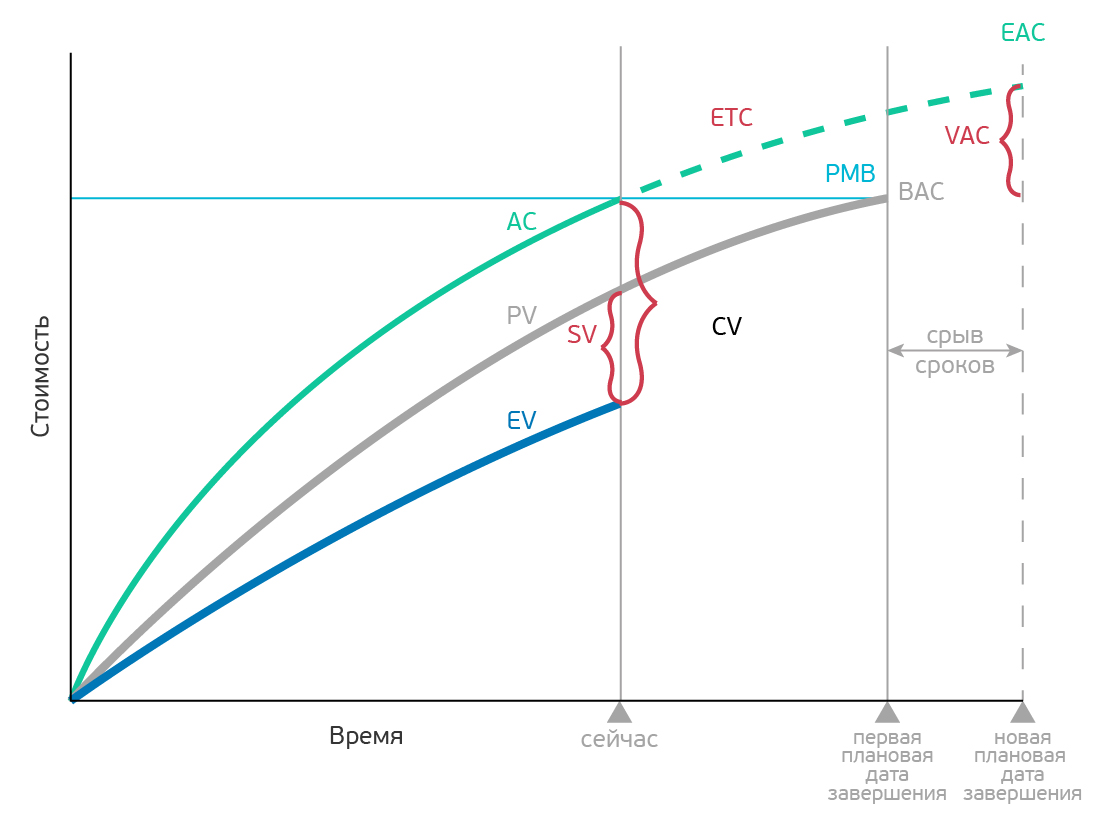
Calculation of all elements of the EVM in the mind map below in easy-to-print format (read - cheat sheet).
EVM elements and their calculation formulas
SV and SPI are considered on the basis of labor costs of completed and planned work. Therefore, it is possible that the work will be completed later than planned, but the indicators will show the ideal state of the project - SV = 0 and SPI = 1. In this case, the method of measuring the performance of tasks is used when time is used as the main indicator - instead of PV and EV, you need to use the planned time (PT) and actually spent time (AT). Thus, when performing the entire scope of work and if there is a delay in execution, it will be possible to calculate alternative values for SV and SPI, focusing on it. The calculation for these quantities is in the diagram above.
For analysis of control points, I recommend using threshold values, setting them to determine deviations that are outside the allowed values. Thresholds will help focus attention on deviations and analyze only significant deviations and trends of the project.
Qualitative variance analysis report contains:
Part of the threshold values should be set more stringent for internal reporting than for external reporting. This helps to focus on performance and identifying possible deviations before they become a problem for the customer.
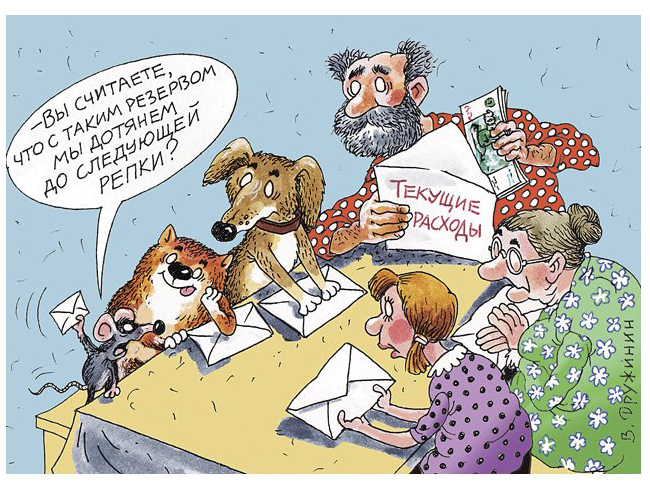 A source
A source
Earned Value Management worldwide has established itself as a useful tool for monitoring performance and getting feedback on the status of a project during its management. Abroad EVM is actively used by such companies as IBM, Jacobs, Toshiba, SAP, Boeing. In Russia, it is not officially recognized by many companies, for example, Lukoil and Renaissance Capital.
In our practice in LANIT, we also use the Earned Value Management technique. Have you encountered in your work with EVM? Have you been helpful to her approaches? I propose to speak in the comments.
PMI develops ideas from ESM (earned schedule management) - managing a learned schedule using EVM approaches. Already, there are Draft mechanics used for ESM purposes, allowing targeted control of the critical path and critical circuit. But this is a completely different story that I can tell, or which you can read about in the Practice Standard for Earned Value Management, 2nd edition (2011), a free PMBOK application for PMI members.
In the meantime, you reflect on what you read, solve a small puzzle, write the answers in the comments.
Correctly answered, welcome to the interview .

Key points of the project
Each manager wants a clear understanding of the state of his project and an answer to the questions: does the project lag behind or is ahead of the implementation plan, how efficiently are resources used, is the budget exceeded or is there savings, what is the cost of the remaining work? For a project to be successful, you need to carefully manage each of its components and processes. The project manager needs constant feedback in order to see possible problems in time and solve them in order to do everything on time and meet the budget.
Earned Value Management helps you manage these tasks. It integrates in itself the analysis of the entire scope of work on the project with the work execution plan and the cost of its implementation. Thanks to her, one can observe the main metrics of the state of the project and assess the real state of affairs, making the necessary managerial adjustments.
')

We are building work on EVM
You are the manager and decide that you will use Earned Value Management. Talk about the practical steps you need to take. First, project planning, then measuring and analyzing the timing of the work and their cost as the project objectives are accomplished.
Are planning
We determine the full scope of work: what should be developed and delivered to the customer. The volume is indicated in the content of work (Statement of work, SOW), we have this term has the usual names - technical assignment, technical / functional requirements. Based on this, a project execution plan is drawn up and the cost is calculated. The beginning is simple, just like in the classics.

Each work is divided into component tasks, which allows you to better control the execution of the plan - work decomposition is performed. After all, it is not for nothing that “an elephant is eaten piecemeal.”
The hierarchical structure of work (WBS, Work breakdown structure, WBS) allows you to specify the project to manageable parts - elements that cover the entire scope of work. To the leaves of the WBS tree, the works are increasingly detailed.

Now we define the contractors and their areas of responsibility - we are preparing the organizational structure of the project team (OS, Organizational breakdown structure, OBS).

After that we strengthen control over the project, designating control points. For them, we determine the amount of work required to perform, the budget and the plan of the work itself. In the future, when carrying out monitoring activities, we will first look at these points for analyzing the amount we have acquired and the actual costs incurred.
Responsibility for these points, the roles of the participants are specified in the Responsibility assignment matrix (RAM) - we carry out the intersection of the WBS (a workload, responding to the question “What should be done?”) And OBS (project participants, responding to the question “Who is responsible for completing the task? ”), thereby determining those responsible for the control points. One person in charge may be responsible for several control points, but a control point cannot be controlled by several persons responsible.
In this figure, control points are highlighted in yellow.

We make the main project execution plan (integrated master schedule, IMS). In terms of all the tasks are divided into stages of the execution of tasks (up to the lowest level of the WBS), indicating their duration and logical connections. Then we mark the budget for each task.

Draw up a budget
To use Earned Value Management, the work plan must be integrated with the planned project costs. At the very end of the IMS planning (I highly recommend it then) it is necessary to develop a budget. The budget must be clearly tied to the time intervals of the tasks in order to understand when and how much budget funds will be spent.

The project budget is one of the main elements of Earned Value Management. It is taken into account:
- in the total planned cost (Budget at completion, BAC), this does not include management reserves;
- in planned values - planned volume (Planned value, PV, or planned cost of planned works, Budgeted cost of work scheduled, BCWS);
- in the “mastered” values - the mastered volume (Earned value, EV) is a reflection of the planned value of the actually performed amount of work for a certain period of time; sometimes it is also called the planned cost of work performed (Budgeted cost of work performed, BCWP);
- in actual values, the actual cost of work performed (Actual cost, AC, or Actual cost of work performed, ACWP).

From the example I mentioned above, the situation on the project is visible - the analytical block of work was carried out ahead of time, but from the moment the requirements were agreed upon, a deviation from the plan began, including in the development ...
The sum of all budgets of control points and the unallocated budget is the basic level of performance measurement (Performance measurement baseline, PMB). It is useful to us to compare the cost during the implementation of the work plan.
You can measure the resources used in any convenient units of measurement (for example, in working hours, in monetary terms of the resources used, which make up the budget, etc.).
Consider the basic tenets of EVM technology:
- in case the task is completed, the used volume is equal to the budget of this task,
- in case the task has not started yet, the mastered volume is zero,
- in case the task continues, the used volume is equal to its budget multiplied by the percentage of its completion.
Measure progress

There are several basic approaches to determining the progress of a task.
Fixed formula
Convenient for small tasks. An example of such an approach is the 50/50 method, when 50% of the completion of tasks are indicated at the start of their execution, and the remaining 50% - at the end. Alternative formulas 25/75 and 0/100 may be used. My favorite ratio is 10/70/20 (start of work, significant execution of the task, and completion of its execution) - allows you to go through a three-stage assessment process 0% → 10% → 80% → 100%.
Weighted check points and
Effective for long-term tasks when there are intermediate results. The task is divided into parts. The end of each part is the control point. After each checkpoint is reached, the task is assigned the appropriate percentage of its completion.
Execution percentage
This is a simple but subjective approach, in which the person in charge of the task himself assesses the percentage of completion of the planned work for the period. Such an assessment is not always effective and believable, but such an approach also takes place.
If there are any quantitative indicators, the percentage can be calculated on their basis. For example, 65,356 out of 110,320 migrated, i.e. 59%.
Distributed work
If the task is associated with another task that has its own EV, the value for the dependent task can be determined based on the main task. These may be synchronous tasks.
Level of load (LOE)
If the result of the task is intangible and the other listed approaches cannot be applied, then use this approach. For example, for such tasks as project management or technical support for users, those responsible for the tasks are occupied for a fixed% of the time. Thus, it is sufficient to simply calculate how much progress there will be if the responsible persons are engaged in these tasks.
Analyzing deviations

Earned Value Management allows you to identify possible deviations from the plans by analyzing your main elements - the amount mastered, the work plan and actual expenses. Based on them, you can determine:
- cost variance (cost variance, CV), indicated in absolute values and shows the overrun or savings on the project;
- deviation in terms (schedule variance, SV), is indicated in absolute values and shows the delay or advance of the work schedule;
- cost performance index (CPI), shows how effectively the project team uses resources;
- The schedule performance index (SPI) shows how effectively the project team uses its time.
How to calculate them? The calculation formulas are simple. Here they are:
; ; ;
If the first two indicators are negative, pay special attention to this, you have a deviation on the project not for the better.
In case the last two indices are greater than or equal to 1, the project is in excellent shape. Conversely, if less than 1, this means that there is a problem in the timing or cost of the project.

Predict
There are other useful elements in EVM for analyzing a project that allow you to answer questions about how much work is left to be done, how much money is left to spend, whether the forecasts are consistent with the current progress of the work. I will give these elements below.
Project completion forecast (Estimate at completion, EAC)
It allows you to determine when the project will end and how much money will be spent on it, taking into account the current trend.
Deviations on completion (Variance at completion, VAC)
Informs about savings or cost overruns at the end of the project in absolute or relative terms for the period.
Performance Index to completion (To complete performance index, TCPI)
Shows the required efficiency of the team using the remaining resources so that at the end the cost corresponds to the BAC values (or EAC, if it was calculated by an expert method). After determining the index, you need to determine what action to take to change the CPI in the direction of the new value equal to TCPI.
Forecast to completion (Estimate to complete, ETC)
Shows the estimated costs of the remaining project work. It can be calculated and expert way, and with the help of mathematical calculations based on the efficiency of the work, determined by the CPI.
Following the results of the forecasting of the project plan execution, I recommend that you record the results of the forecasting and measurement procedures in the charts / pivot tables, this will help to see the trends and the life of the project, its history. We do not forget to take corrective management actions to preserve the successful implementation of the project, because it is not without reason that change management is one of the core competencies of a project manager in the IT world.
To understand how the elements of EVM are related to each other, below I will draw a graph of the dependence of elements.

Calculation of all elements of the EVM in the mind map below in easy-to-print format (read - cheat sheet).
EVM elements and their calculation formulas
SV and SPI are considered on the basis of labor costs of completed and planned work. Therefore, it is possible that the work will be completed later than planned, but the indicators will show the ideal state of the project - SV = 0 and SPI = 1. In this case, the method of measuring the performance of tasks is used when time is used as the main indicator - instead of PV and EV, you need to use the planned time (PT) and actually spent time (AT). Thus, when performing the entire scope of work and if there is a delay in execution, it will be possible to calculate alternative values for SV and SPI, focusing on it. The calculation for these quantities is in the diagram above.
For analysis of control points, I recommend using threshold values, setting them to determine deviations that are outside the allowed values. Thresholds will help focus attention on deviations and analyze only significant deviations and trends of the project.
Qualitative variance analysis report contains:
- description of the problem,
- the reason for deviations
- measures to reduce the impact of deviations on the project.
Part of the threshold values should be set more stringent for internal reporting than for external reporting. This helps to focus on performance and identifying possible deviations before they become a problem for the customer.

We use in practice
Earned Value Management worldwide has established itself as a useful tool for monitoring performance and getting feedback on the status of a project during its management. Abroad EVM is actively used by such companies as IBM, Jacobs, Toshiba, SAP, Boeing. In Russia, it is not officially recognized by many companies, for example, Lukoil and Renaissance Capital.
In our practice in LANIT, we also use the Earned Value Management technique. Have you encountered in your work with EVM? Have you been helpful to her approaches? I propose to speak in the comments.
Afterword
PMI develops ideas from ESM (earned schedule management) - managing a learned schedule using EVM approaches. Already, there are Draft mechanics used for ESM purposes, allowing targeted control of the critical path and critical circuit. But this is a completely different story that I can tell, or which you can read about in the Practice Standard for Earned Value Management, 2nd edition (2011), a free PMBOK application for PMI members.
In the meantime, you reflect on what you read, solve a small puzzle, write the answers in the comments.
Task
The end of summer, the project is nearing completion and really want to go on vacation. Project manager Ivan wondered if he could afford it at the end of his project, and decided to use the EVM technique to understand where his project is now, see if his team is allowed to relax a little while he is on vacation.
And the situation in his project is not easy.
The project employs 3 programmers - Vyacheslav, Roman and Egor (with a salary of 100 gold per day) and 1 analyst Peter (with a salary of 120 gold per day), and of course he himself (with a salary of 143 gold per day). At the project committee, the project plan was adopted with a baseline duration of 4 months.
At the beginning of the project, analyst Peter met the deadline for preparing materials for his fellow programmers to within a second, the statements were verified and agreed with the client, the specifications for development were perfected to "11 decimal places". And with a clear conscience, leaving work, he wrote a letter to the developers about the availability of materials for them two weeks later (as planned earlier) after the start of his work. But I forgot to attach the number from Jira with the materials of the tasks, the mail server was just inaccessible, and the letter hung in the outbox.
The next day, the developers, seeing that there were no letters from their friend Peter, on the initiative of good-natured Yegor decided to help on another project, where at that time a fire was raging that was being extinguished by the whole company.
By the end of the second day, Petya decided to clarify whether everything is in order, and what happened, why the guys did not answer at Jira, that they took to work. And then the problem was revealed. So Peter, who was in a hurry, did not control the task’s acceptance into the work, not knowing himself, questioned Ivan’s vacation.
There was a little more than three months of work ahead, specifications and statements did not cause additional questions, and the team worked steadily without processing (8 hours a day), everything was on their side to hand over their part of the project on time. This situation was until the next birthday of Ivan, which came 2 months after the start of the project. After the celebration, Roman “broke down”, and went to the hospital for 2 weeks. Understanding all the responsibility, Roman, after leaving the hospital, worked out 11 hours a day.
And now, a week after Roman left the holiday, our Ivan asked himself the question: "Can he afford to leave at the end of his project?"
The task
Help Ivan :) Can he go on vacation, according to sound logic after analyzing CPI, SPI, SV, CV, TCPI. Attach the calculations of these indicators and indicators, schedule EV / AC / PV.
And the situation in his project is not easy.
The project employs 3 programmers - Vyacheslav, Roman and Egor (with a salary of 100 gold per day) and 1 analyst Peter (with a salary of 120 gold per day), and of course he himself (with a salary of 143 gold per day). At the project committee, the project plan was adopted with a baseline duration of 4 months.
At the beginning of the project, analyst Peter met the deadline for preparing materials for his fellow programmers to within a second, the statements were verified and agreed with the client, the specifications for development were perfected to "11 decimal places". And with a clear conscience, leaving work, he wrote a letter to the developers about the availability of materials for them two weeks later (as planned earlier) after the start of his work. But I forgot to attach the number from Jira with the materials of the tasks, the mail server was just inaccessible, and the letter hung in the outbox.
The next day, the developers, seeing that there were no letters from their friend Peter, on the initiative of good-natured Yegor decided to help on another project, where at that time a fire was raging that was being extinguished by the whole company.
By the end of the second day, Petya decided to clarify whether everything is in order, and what happened, why the guys did not answer at Jira, that they took to work. And then the problem was revealed. So Peter, who was in a hurry, did not control the task’s acceptance into the work, not knowing himself, questioned Ivan’s vacation.
There was a little more than three months of work ahead, specifications and statements did not cause additional questions, and the team worked steadily without processing (8 hours a day), everything was on their side to hand over their part of the project on time. This situation was until the next birthday of Ivan, which came 2 months after the start of the project. After the celebration, Roman “broke down”, and went to the hospital for 2 weeks. Understanding all the responsibility, Roman, after leaving the hospital, worked out 11 hours a day.
And now, a week after Roman left the holiday, our Ivan asked himself the question: "Can he afford to leave at the end of his project?"
The task
Help Ivan :) Can he go on vacation, according to sound logic after analyzing CPI, SPI, SV, CV, TCPI. Attach the calculations of these indicators and indicators, schedule EV / AC / PV.
Correctly answered, welcome to the interview .
Source: https://habr.com/ru/post/428061/
All Articles
